How to work with its difficult characteristics and beneficial properties
I grew up on a small farm about 12 miles from where I now farm in the high desert of Oregon (zone 6b). That farm was in the middle of the Grande Ronde Valley where there are 200 feet of “topsoil.” If asked about our soil, my mom’s joke was always, “I found a rock — once.” It was a dream to garden in and to dig a post hole. I thought that’s just how soil was — friable, rich, and deep brown.
Today, I live in the foothills of the same valley on a pile of clay. The first year on this farm I tried to grow potatoes. The plants grew well and looked healthy. When it was digging time, I headed out with my dad to reap the harvest as we have my whole life. We managed to wrench potatoes from the clay and found they were not round, but square because the clay had constricted them. This was my first hard realization that things would be different on this farm.
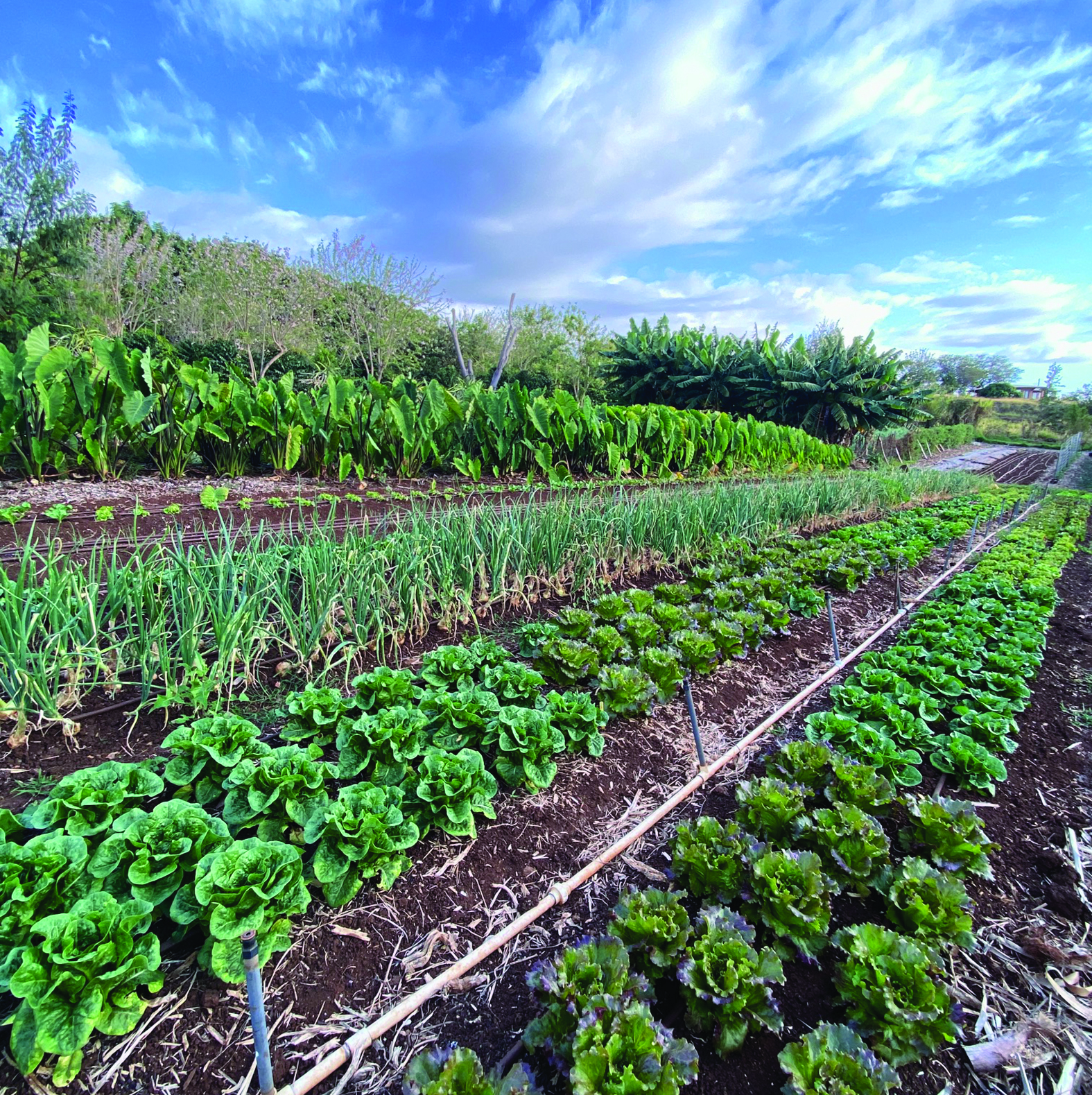 Kupa’a Farms’ soil after 20 years of improvement.
Kupa’a Farms’ soil after 20 years of improvement.
I have been building soil for going on 10 seasons now, but I still have a lot to learn about farming with clay. I have found that most market farming books don’t mention clay or its particular challenges. Many suggested practices and tools that just won’t work on clay. For this article I interviewed several folks at various stages and various climates about how they have learned to live and farm with clay.
What is clay?
All soils are made up of different amounts of sand, silt, and clay. Sand is the biggest particle size, silt is in the middle, and clay the tiniest. The largest clay particle is more than 1,000 times smaller than the smallest sand particle. In the book Soil Science for Gardeners, author Robert Pavlis wrote clay particles are “…so small they can’t even be seen with a light microscope.” He adds: “Unlike sand and silt, which result from rocks breaking up into smaller and smaller particles, clay is formed when very small minerals stick together to form larger particles.”
Clay has very small pores, which is why it has high water-holding capacity or is poorly drained, depending on how you look at it. As Pavlis writes, “A handful of sand has a surface area equivalent to the top of a table, whereas a handful of clay has a surface area equal to a football field. For this reason, clay holds much more water and stays wet much longer, making it easy for roots to get water for a longer time.”
Difficulties with farming in clay
Clay particles make tight soils with less air space because they are small and can crowd close together. Clay soils are known for being sticky; poor to drain; and to crust, crack, seal up, and swell when wet and to shrink when they dry. One farmer I talked to, Mike Bell at Quarter Acre Farm in Dallas, said his soil can create “ankle-breaking cracks” when it dries out in the Texas heat.
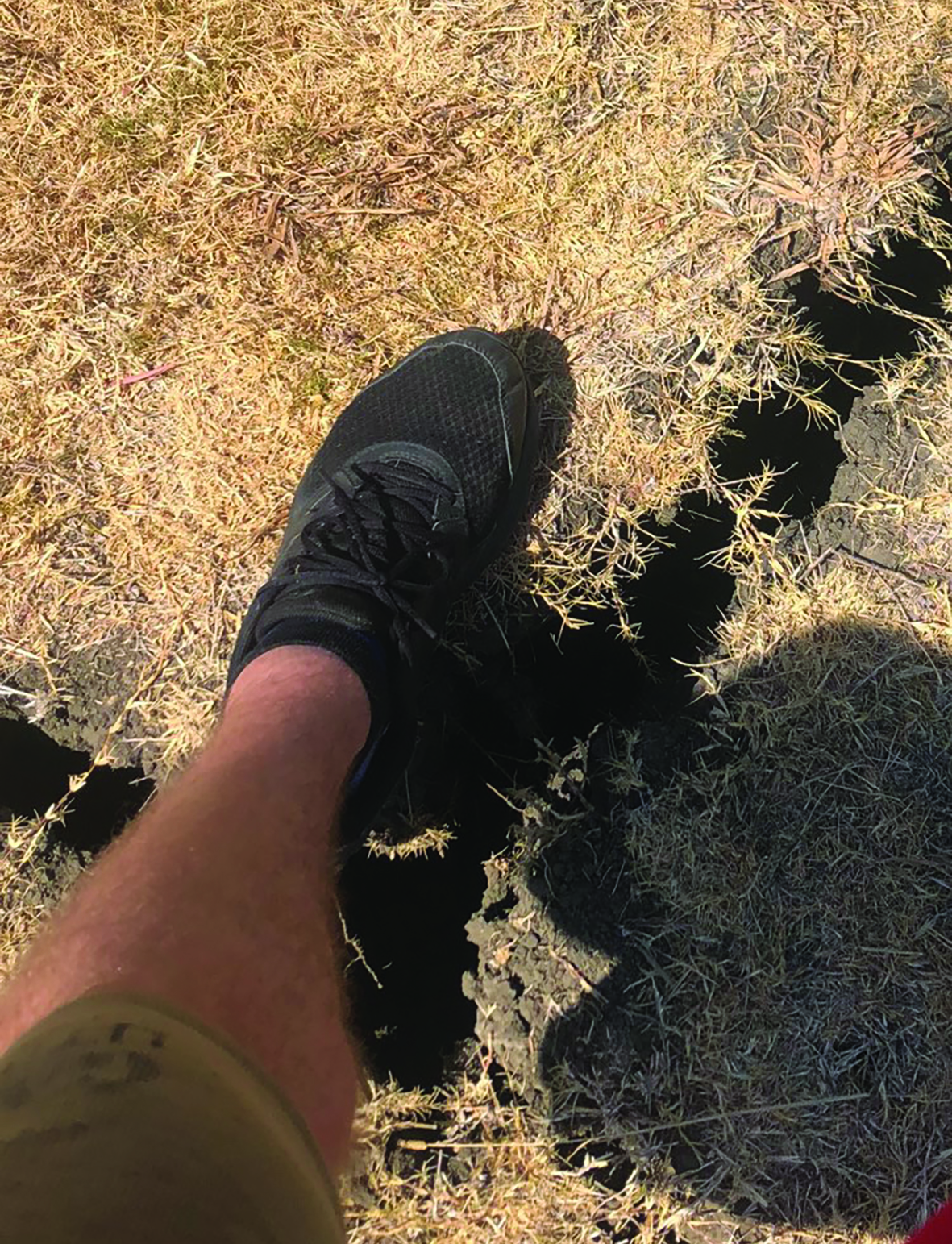 Ankle breaking crack on Quarter Acre Farm.
Ankle breaking crack on Quarter Acre Farm.
Clay is easily compacted especially because it is slow to drain and the particles are flat, thin plates that can pack very close together. Think of slices of bread or sheets of paper. Clay particles also stick together because they are often negatively charged. Clay pans at the root zone can keep water from moving downward and drown plants. Clay crusts when it dries but it can also crust from raindrop impact. Clods and tightness of clay make it difficult to direct seed crops and even if you get the seed in, crusting or runoff can impact germination. But then, clods and tightness also make transplanting difficult, especially because most tools seem designed for the ideal loam soil.
But the flip side of these difficult characteristics are beneficial properties. Clay has a high water-holding capacity, which is very beneficial in my high desert environment. In sandy soils, water runs through more quickly and needs more frequent irrigation. Cation Exchange Capacity (CEC), or the ability of a soil to hold nutrients, is high in clay. Clay particles have a slight negative charge, so they hold on to cation nutrients, such as a positively charged ammonium, which prevents water from washing them away. However, clay can also hold more tightly to herbicides and chemicals which means they stay in the soil longer.
Even Pull Farm, McMinnville, Oregon
“Clay is the shaper of my reality farming on this property,” said Beth Satterwhite. She and her partner Erik Grimstad are in their 11th season farming mixed vegetables and flowers, nine on this land near McMinnville, Oregon in zone 8a, which receives about 54 inches of rain annually, primarily in winter.
Farmers interviewed for this article fell into two broad strategies for dealing with clay. I fall into the first camp: bury the clay. Beth falls into the second: work with the native soil. Even Pull Farm uses soil amendments, well-timed tillage, and water management to work around the natural limitations of clay. They have seen a great improvement by amending with gypsum. Gypsum is calcium sulfate and can make clay soils more workable. Beth works with an agronomist each year to determine the kind of fertilizer and level of gypsum to add.
Think of clay soil as layers of paper, Beth says. When you add gypsum, the positively charged calcium ions interacts with the slight negative charge on the clay particles and adds space between the layers making the soil less tight. But gypsum only works on certain clays and in certain situations. There are a lot of internet myths about gypsum, so it pays to work with an agronomist or extension agent to determine whether gypsum can help your clay soil.
Beth also emphasizes that understanding soil moisture is one of the most important things to learn for clay farmers. “When you’re figuring out how to work a clay soil, you learn the middle ground when to till based on moisture.”
It took about three years to learn when she could till — she tills but tries to limit it — or even when to enter the field to plant. Sometimes she would start on a project but abandon it when it became clear the soil was too wet. “You can’t force tillage in clay,” she said. “Sometimes I start and after 10 feet, I have to give up.”
In clay it is a difficult dance. She does one pass with the tiller when flipping a bed unless she’s incorporating mulch. She uses silage tarps heavily to protect the soil surface, keep down the weeds, and keep the soil drier.
 Kupa’a Farms before (right) and after (left). The original dense red clay soil is on the right, and then on the left you can see the difference after life was reintroduced with air holes and worm tunnels.
Kupa’a Farms before (right) and after (left). The original dense red clay soil is on the right, and then on the left you can see the difference after life was reintroduced with air holes and worm tunnels.
Inside her hoophouses, she has no-till beds. “The tilthy quality in the houses is possible because that soil isn’t getting pounded by rain for six months a year,” she said.
Covering the soil surface with landscape fabric during the growing season can help prevent crusting and help germinate direct seeded crops like carrots. Beth checks under the landscape fabric every day for germination and removes the landscape fabric when they emerge. She uses landscape fabric because that’s what she has.
In my clay soil and desert climate, I use white row cover to similarly germinate carrots and other seeds. I deal with a lot more temperature extremes in eastern Oregon than Beth in western Oregon, so I have row cover for miles to both protect from frost and to retain moisture during summer germination. Both fabrics work but landscape fabric must be removed quickly upon germination.
In terms of tools for working clay, Beth finds stirrup hoes work best. “A collinear hoe ain’t getting through that,” she said about her clay soil. Ditto for drill-driven tilthers, gridders, and wheel/basket weeders. Eleanor Lonardo at The Borrowed Garden farm says she has broken dozens of digging forks and abandoned her Hori Hori knife for a simple floral spade. We all lamented several “as-seen-on-Youtube” tools that we bought, tried on clay, and never used again.
But like all the farmers I interviewed, Beth also has come to appreciate some things about clay. “Clay has a great water-holding capacity and is definitely interesting to farm in,” she said. She also wonders if it grows tastier food. At a workshop taste test of carrots grown in sandy, loamy, and clay soil, the carrots from clay had much more flavor. She wonders if the increased availability of nutrients due to the high CEC in clay could improve taste.
Kupa’a Farms, Kula, Maui
Gerry Ross of Kupa’a Farms lives on the dry, lee side of Maui in zone 9b with 10 to 12 inches of rain annually. He is a geologist, so I learned a lot about clay from his background and farming experience. He and his wife took over her family’s farm about 20 years ago and began converting the farm from conventional to organic and toward low/no-till.
“We have been challenged by the clay-rich soils here,” Gerry said. “It has been a challenge to figure out the right recipe and combination of conditions to make them soft enough and responsive to broadforking,” he said.
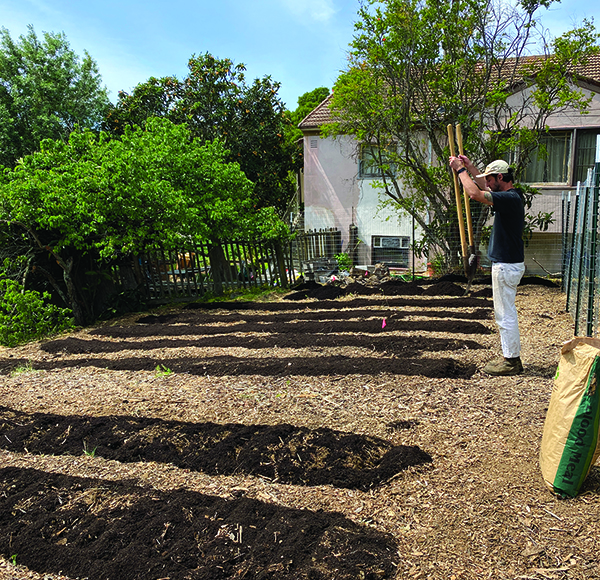 Broadforking at The Borrowed Garden.
Broadforking at The Borrowed Garden.
As many of us experienced, typical market garden tools in his context did not work. “The 9-horsepower BCS tiller is a hazard to life and limb in our soil,” Gerry explained laughing. He said the BCS tractor bucked and launched off the ground when he tried to get it through his beds. I can relate.
To put this in perspective, one of the tools of choice or need at Kupa’a is the pickaxe. “We have a lot of Bermuda grass and it is really difficult to get out of clay soil,” Gerry said. Most people think pickaxes are for mining, but they are necessary in clay farming. The clay at Kupa’a Farms has a special clay feature that I don’t have at my farm in eastern Oregon: greasiness.
“The soil is greasy and slimy when wet, but when it dries out, it becomes concrete,” said Gerry. “There is no solution to this.” He can’t buy a bag of something to change these characteristics.
As I read in an Oregon State University Extension article, “Clay, like diamonds, is forever.” While gypsum worked at Even Pull Farm, it won’t work for the type of clay that Gerry farms with. “Smectites are expandable clays with a slight negative charge that will respond to gypsum,” Gerry explained. The halloysite clay of Hawaii and other clays such as those of Piedmont of southern Appalachia have a neutral charge which means they won’t react with gypsum.
Kupa’a Farms instead has focused on increasing organic matter in the clay to improve the soil. They use homegrown compost and flail mow cover crops including Piper sudangrass, sun hemp, and buckwheat. Every other year he gets a soil analysis and amends accordingly. He also uses a local product, coffee chaff, to improve the soil. While coffee chaff doesn’t add much in terms of nutrients to the soil, it does improve the tilth and workability.
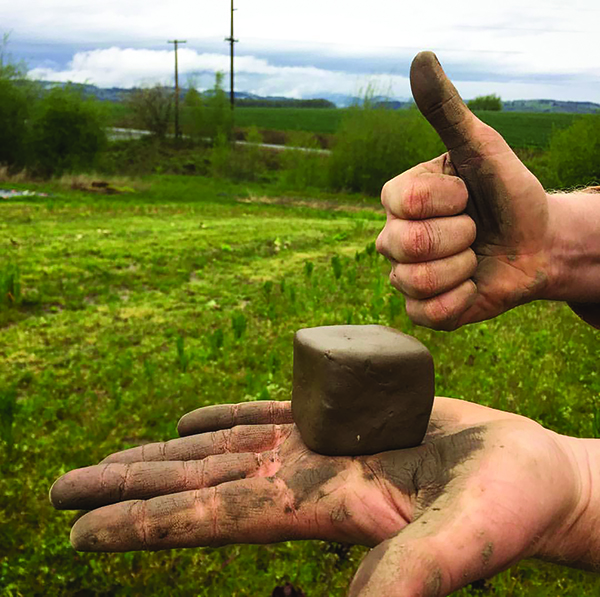 Even Pull Farm clay is good enough for pots (or cubes).
Even Pull Farm clay is good enough for pots (or cubes).
In my region, the local equivalent of coffee chaff is mint slugs, or the chopped waste product of mint harvest and oil extraction. I have 28 tons of mint delivered to my place each year which makes the basis of my compost. It arrives steaming after it is heated to 550 degrees and dries out to basically mint straw. Coffee chaff and mint add organic matter and lift to the soil and help create a workable top layer. Another farmer I interviewed, Nick Listo at Oak Holler farm in Marshall, North Carolina, recommends rice hulls, which he orders in bulk, for the same reason.
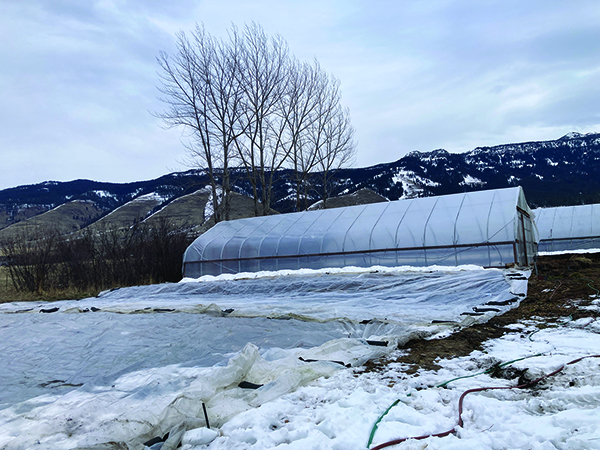 The author keeps the soil covered all winter to keep it dry with old greenhouse plastic (tarps are expensive!).
The author keeps the soil covered all winter to keep it dry with old greenhouse plastic (tarps are expensive!).
Just like at my farm and Even Pull Farm, Gerry has difficulty direct seeding crops due to crusting and tilth. At Kupa’a Farms transplanting is done by hand because something like a paperpot transplanter would not work. Each 100-foot bed is broadforked before transplanting, which only takes 20 minutes in ideal moisture conditions. To make transplanting go faster, they use a dibbler that is a variation on a broadfork that pokes six holes at a time to plant things like garlic and onions.
Also similar to my farm and Even Pull Farm, Kupa’a works to keep the soil surface covered to prevent the clay from drying out, cracking and crusting. “We cover beds with palm mulch from palm tree prunings if they aren’t going to be planted right away,” said Gerry. “It has the same effect as silage tarps. It keeps the soil from baking in the sun.”
Unlike Even Pull Farm in the rainy Willamette Valley, Gerry and I farm with clay in dry environments where clay provides some advantage in terms of water retention and decreased need for irrigation. In talking to fellow farmers in dry Oregon who have sandy soil, I realize that while I don’t have a perfect loam, clay is a comparative advantage when irrigation water is scarce.
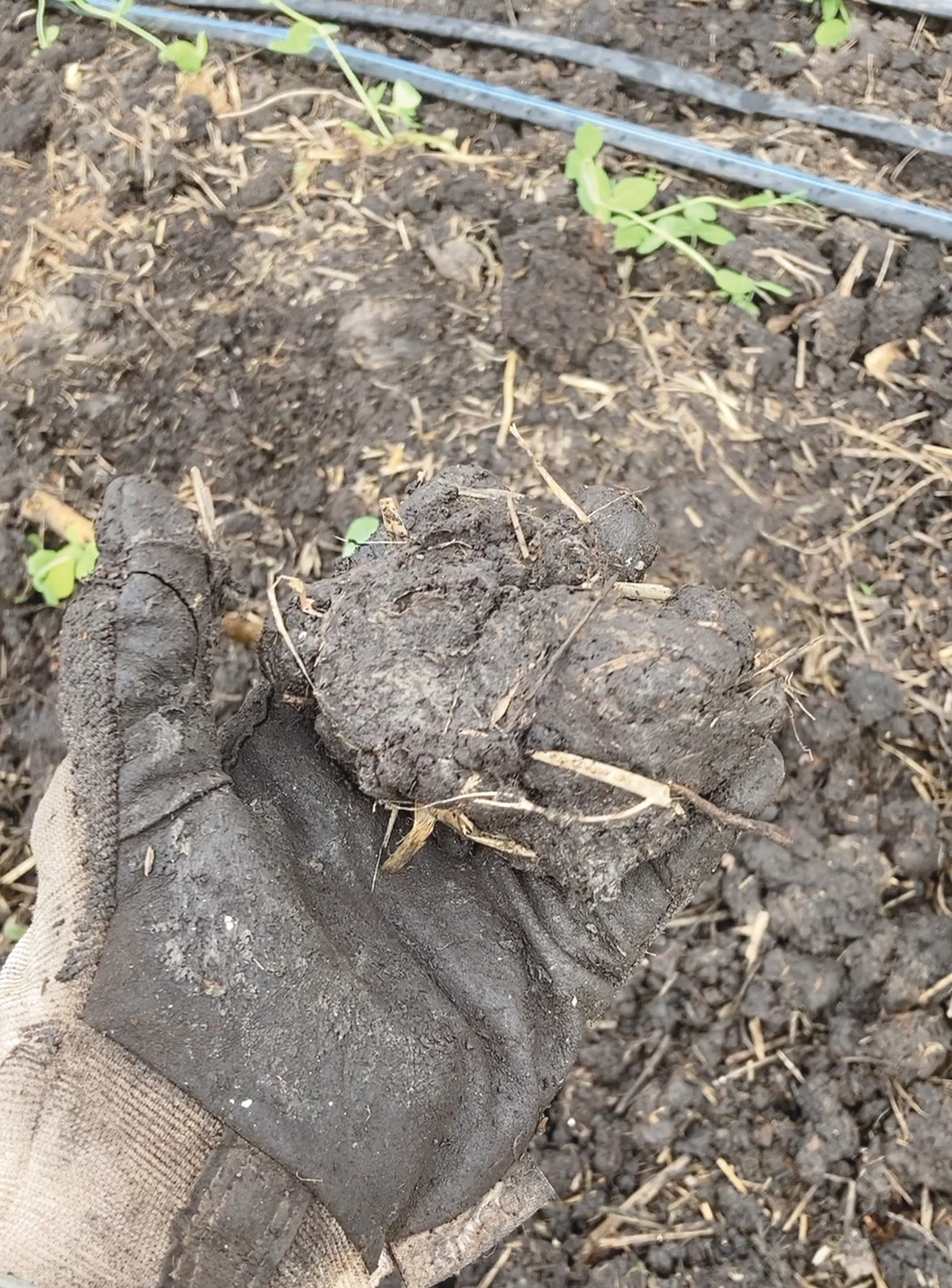
Clay clod on the author’s farm.
The other huge advantage of clay is soil particle aggregation. Clay, as well as microbes, help create soil aggregates which tillage destroys. Soil aggregates create larger pores for water to move through. When you pair clay with active soil biology you can mitigate slow water infiltration that creates pooling and run off.
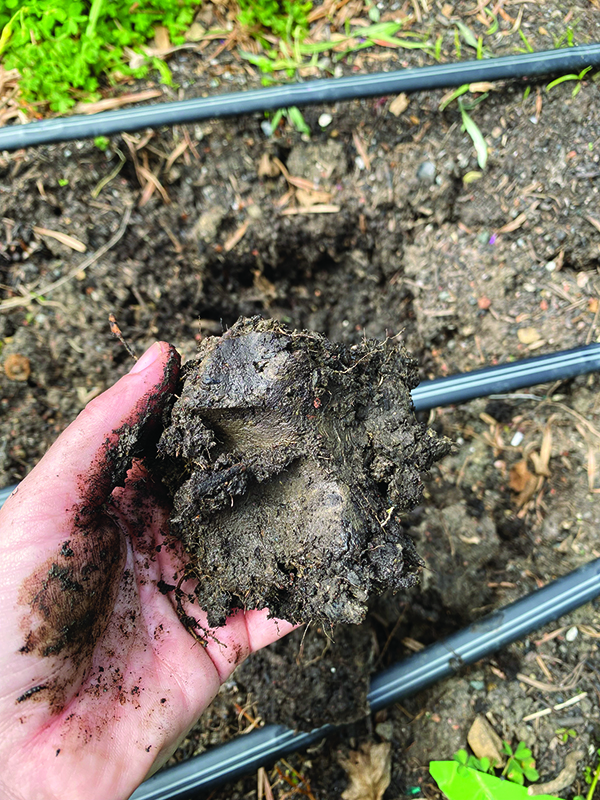 The Borrowed Garden’s clay.
The Borrowed Garden’s clay.
“We rarely get pooling,” Gerry told me. “In January a storm dumped 10 inches of rain in three days, which is one million gallons of water on our farm,” he said. “We had no run-off or pooling because soil life increases porosity.”
North Carolina, Texas and California
I also talked to Nick in North Carolina, (Zone 7a); Eleanor in Crockett, California, (Zone 9b); and Mike in Dallas, Texas (Zone 8b.) These folks echoed a lot of what Even Pull and Kupa’a farms said. Here are some common threads when it comes to farming with clay.
Increase organic matter. Organic matter makes soil more workable for the farmer, more hospitable for plants and soil life, and helps mitigate greasiness, stickiness, and slow water infiltration.
Keep the soil covered. Clay bakes, crusts, shrinks, and cracks in the sun and is susceptible to damage from pummeling rainfall. Tarping is not just for the winter months. Tarps, mulch, and landscape fabric can protect the soils from physical damage and keep the soil more moist for germination and soil life.
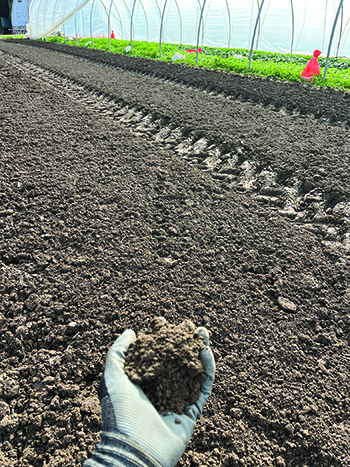 Even Pull Farm soil after tilling.
Even Pull Farm soil after tilling.
Lots of tools aren’t made for clay. Broadforks, stirrup hoes, and rippers were favorite tools of these clay farmers. Some of us also use the power harrow and flail mower BCS attachments. Collinear hoes are a joke and pickaxes may be needed. A lot of tools will be a waste of money for clay farmers.
Tillage — it depends. Several farmers expressed that use of tillage has become a morality test in market gardening, and those who use it are failing. Tillage and working the soil is all about context. For some of these clay farmers, tillage has been helpful and necessary. Tillage is just another land management tool, like fire, grazing, or tarps, to be used judiciously and at the right time. In clay, there is a very narrow moisture level in which tillage can be done and each farm has to be very tuned in to make it work.
Cover crops such as sudangrass, winter (Austrian) peas, buckwheat, wheat, rye, and alfalfa can be helpful for covering the soil surface, adding OM and breaking up the soil. Nick and I have both found daikon and tillage radish excellent in clay because they have deep roots that make long holes in the soil for water to move through.
Other Tips
Mike suggests standing out in downpours and watching how water moves over the landscape. He works with his landscape and digs trenches to move water away from prime growing areas. He also works around his impenetrable clay by planting tomatoes horizontally rather than vertically since tomatoes can grow adventitious roots (i.e. roots that grow from an organ other than a root) from the stem.
A lot of my tricks at Nella Mae’s Farm are all about timing. I do as much as I can to prepare for the next season in the fall because it is drier. I can’t count on the soil to be dry enough in the spring to power harrow or even broadfork, so that must be done in the fall. I use a lot of 4-foot hoops and old greenhouse plastic to keep water and snow off my beds early in the spring.
I use a lot of gravel and wood chips to keep out of the clay muck. When we have built or repaired deer fence or hoophouses, we just pay for an excavator to come out and drive wood posts we sharpen to a point with the chainsaw into the ground. Post hole diggers/clamshells and augers are a waste of time at my farm.
The techniques clay farmers use, such as covering the soil surface with tarps, are familiar to farmers with other soil types, but we may lean on them more heavily or for different reasons. They have all seen improvement in their soil by using a careful recipe of soil surface coverage, tillage/broadforking, and water management.
All the farmers I talked to have learned to appreciate clay at some level and probably have a remixed serenity prayer similar to mine. “God grant me the serenity to accept the clay I cannot change and courage to farm as I can. I surrender to the soil, farming one day at a time.”
Nella Mae Parks farms on her family place in Cove, Oregon, growing vegetables for her on-farm farmstand, the farmers market, and wholesale outlets in the region.
